GETTING LURED INTO THE RIVERLAND THIS AUTUMN
Lubin Pfeiffer provides more cutting-edge information on fishing the Murray with lures over the next few months.
The Murray Darling River system is an amazing part of our country to fish and explore. While there is good fishing to be had throughout the year, autumn is one of the best times to fish the river. The irrigation season has finished and flows are usually at their lowest. This means much better clarity throughout the rivers, and steady flows always have the fish biting more consistently. In this article I’ll run through a few of my preferred tactics and techniques for fishing the river this autumn.
Firstly, let’s take a look at fishing for golden perch with blades. What I love about goldens, callop, yellas, whatever you want to call them, is there is usually a good number of them to catch if you target them for the day. You’ll find them cruising along the rock walls, sitting around timber or even sometimes just hovering mid-water around nothing in particular. They hit lures hard and always put up a good fight before finding their way into the net.
JIGGING BLADES FOR GOLDENS
Blades would have to be the easiest way to connect with a golden on a lure. These little metal vibration lures have accounted for an astonishing amount of fish in the river. The size of the blade is hugely important and, interestingly, smaller models seem to be far more effective than larger models. This is purely because of the situation they are being used in. Jigging a smaller profile blade will create the most amount of action for the least amount of movement. Blades that are 40-50mm in length will have a far more aggressive, tight wobble than larger ones, which need more distance in the rod stroke to get a hard wobble. With a hard wobble on a short rod stroke you can keep the blade in a small area so the goldens can find them.
I have a couple of favourite blades for the job – the TT Switchblade in 7g, which is 43mm in length, and the other is the TT SwitchMinnowz in 37mm and 6.5g. While I use the Switchblade straight out of the packet, I know changing the hooks to small assists can really improve the hook-up rate for fish that are not fully committing. The Switchminnowz come standard with a pair of small assists on the back, which is awesome. You can fish them on either a baitcast or spin outfit, but personally, I like a spin rod.
As a good all-round set-up I’ll fish a 2.1m, 3-6kg fast action spin rod matched to a 3000-size spinning reel. This is loaded with a brightly coloured 4.5kg braid and I like a 10kg fluorocarbon leader. In this situation I think a fluorocarbon leader is important, as not only is it hard-wearing, but you always get a far better transfer of information back through the line. You can feel every bit of timber, whether the lure has slime on it or even the most subtle bites. Better quality fluorocarbon will be a thinner diameter for its breaking strain than the cheaper stuff, which means the leader won’t be influenced by the current as much and the smaller blades will stay in the zone better.
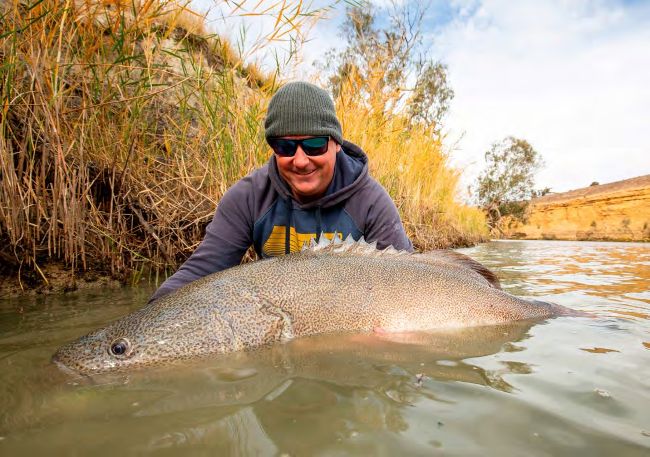
Big cod are always the Holy Grail
The best way to get a bite, in my experience, is to use the blades vertically, and not cast them. This means either tying up to a snag, fishing a slow drift, or finding individual fish on the live sonar. Short, sharp lifts of the rod will get the goldens excited and they should still be able to find the lure. Remember, a blade is a thin piece of metal moving quicker than you think, so by not moving the rod too much, the fish will be able to find it. Move the rod only about half a metre or so for each lift, and this should be more than enough to get that nice hard wobble from the blade. If it doesn’t, then consider trying a different blade, probably one smaller in size.
One hugely important part of the retrieve is the lure sinking back down. It’s amazing how many fish will eat the blade as it is sinking, so staying in contact is essential. I like to follow the line back down with my rod tip and stay tight to the blade rather than letting the line get any slack in it. It makes a lot of sense that many of the yella’s eat the lure as it is sinking because when you think about a fleeing shrimp, it will kick its tail away from danger, but then pause and sink slightly before kicking away again. This slight pause and sink is when I think the yella’s seize the opportunity to strike.
When moving through the snags, the pace that you fish them will depend on how much fishable water you have access to. If you have a lot, then move through each snag fairly quickly and find one that has hungry fish on it. Realistically, you’re going to find out in the first five minutes if there’s an angry one on the timber, but if something hasn’t happened in ten minutes, I’ll be looking to try another snag.
SPINNERBAIT FISHING FOR BIG COD
Without a doubt, my favourite lure and technique to use on the river is spinnerbaiting. I’ve always had a fascination with spinnerbaits. They are such an interesting looking lure, but I really like their versatility, as you can fish them fast or slow, deep or shallow and the fish absolutely love them!
I would say I’ve caught more big cod on spinnerbaits than any other lure.
There is a stack of different variations of baits on the market, and most will work at different times. To keep things reasonably simple, I’m just going to look at one model – the twin spin. If I had to choose just one spinnerbait to throw for cod, it would be a twin spin because they can be fished nice and slowly. With two blades to slow the lure down, it sinks slower than any other lure and also can work slowly through snags of any depth. They also create a lot of noise to attract attention.
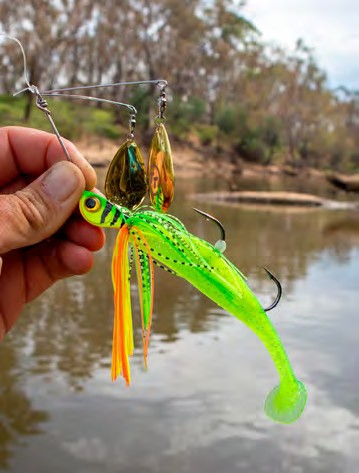
The one I use is a TT Tornado+, which I helped design. It’s got some key features that help you to stay fishing for longer, but it is also a bait that is easy to use. They come pre-rigged, so you don’t need to worry about which plastic trailer to run with the lure or which stinger hook you need to attach. They are a 21g bait, which is perfect for most situations on the river. I usually fish the TT Tornado+ on a 7’3”, 12-25kg swimbait rod so I can cast it repetitively throughout the day easily. My line is always a 24kg braid and a 36kg copolymer leader.
The technique is actually very simple; the difficult part is being able to stick with it long enough to be able to find the right fish that is up and about. Every big good-looking snag has the potential to hold the fish of a lifetime. You just need to put a few casts at each one to find the hungry cod. This may happen on the first cast of the day, or it might be the last.
Live sonar has definitely helped hugely with this because you can see what’s under the water, but it is not the silver bullet. It really depends on the snag. Sometimes you can see the whole thing easily with the sonar and discover that there is not a fish on it, but many others, and often the best ones, require a few casts to see if anyone is home. Even the biggest cod can blend in with the timber and you will not see it on the Live. What’s good to know is that if you can’t see the fish out and about, chances are it is sitting in amongst the timber you are casting at. Even with the help of Live you still need to work through each good-looking snag methodically to find the right fish. A couple of casts at each is usually enough. I like to make a couple of shallow casts past the tips and then sink a few deep into the snag. One thing I will say is that, more often than not, the active fish will be sitting somewhere on the front two-thirds of the tree.
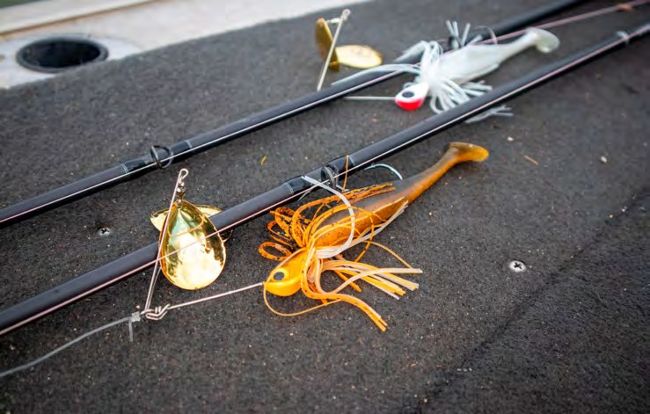
Carrying different colours makes sense
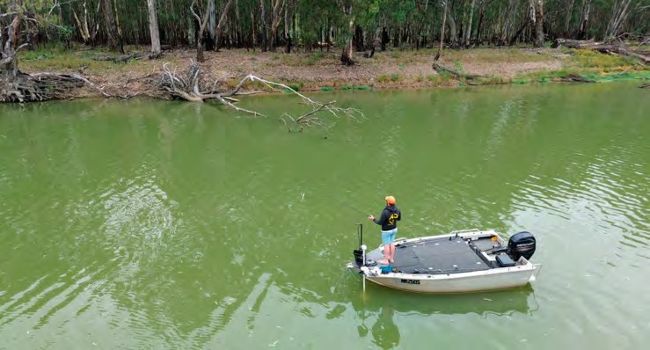
Casting at bankside snags is the go-to
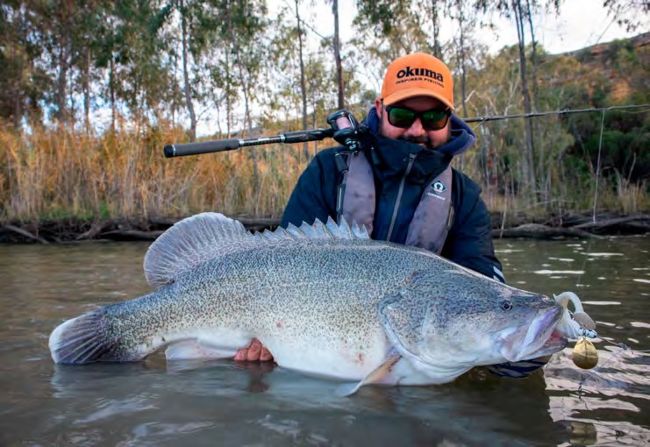
Another beautiful spinnerbait victim
What the Live is amazing for is finding all of the best underwater snags that I would normally drive past. On one trip recently I found a large underwater root base completely submerged with no visible sign from the surface. I couldn’t see any fish on there, but after half a dozen casts a 90cm cod raced out and grabbed the spinnerbait. I fished the next two visible snags for nothing before finding another submerged one and had another cod race out and smash my spinnerbait.
GOLDENS FROM THE SHORE
While you can absolutely have some great fishing from the boat or kayak throwing spinnerbaits for goldens, I really enjoy fishing them from the shore. It’s actually a super effective way to target goldens because they do enjoy following a lure right to the bank before eating it! There is something so rewarding about being able to catch some really nice fish on lures just walking the bank as well.
For this style of fishing I like smaller single-arm spinnerbaits. Without a doubt, my favourite to use is the TT Froggerz Jnr. This is a 14g bait that comes pre-rigged with a stinger hook that’s perfect for goldens. It is nice and compact and casts like a bullet, which is the key when you are fishing all the pockets along the bank in amongst the snags. I’ll fish this on a 4-8kg, 2m long baitcast rod and matching reel spooled with a 10kg braid and a 20kg copolymer leader.
One big thing I will say before we continue is, if you want to get the best out of your shore-based fishing, the right footwear is a must. There are some areas you can fish barefoot, but I would say 95 per cent of all the good spots require sturdy footwear. I like to wear a good pair of wading boots and neoprene socks. Depending on the weather, I’ll either run lightweight fishing pants to protect my legs from sticks or breathable waders if it is cold. Normal boots are fine, but you can get in and out of the water with wading boots without any hassle. This is great for retrieving lures or getting to hard-to-reach logs for a better cast. With the right footwear the fishing area is opened up so much more.
When fishing from the shore, you really just want to cover any of the available water. If there is heaps of it, you can just focus on the best bits, like any trees or rocks, and keep on the move. If there’s not a whole heap of water, slow down and work through each bit really methodically. What I love about this style of fishing is that it really gives you a different perspective on the river. Quite often you’ll pull a fish from a pocket behind a big root base, which is somewhere you probably wouldn’t even consider covering when you are in a boat or kayak.
Yella’s don’t need much water to hide, and chances are if there is a metre or two of depth and some good cover, there will be a fish waiting to ambush in there. The big key to bank fishing is to not cast a mile and try to always fish along the bank. That way, if you do get snagged, you can get a different angle on the snagged lure and with a few flicks more often than not, it will come free. My last morning session walking the bank yielded five big yella’s and a few missed, which is great fishing in anyone’s book. So far this year, I’ve had plenty of yella’s and a couple of cod to 90cm from the bank, and look forward to what happens on the next land-based mission!
There are so many different techniques to catch fish on lures on the river these days; these are just a few of my favourites! After a few flood years and some extra flows coming down the system, it looks like this year is setting up to be a corker, with steady flows and good fishing. As the weather begins to cool, the fish feed up before the breeding season, so there’s never been a better time to get out and try some lures on the river!
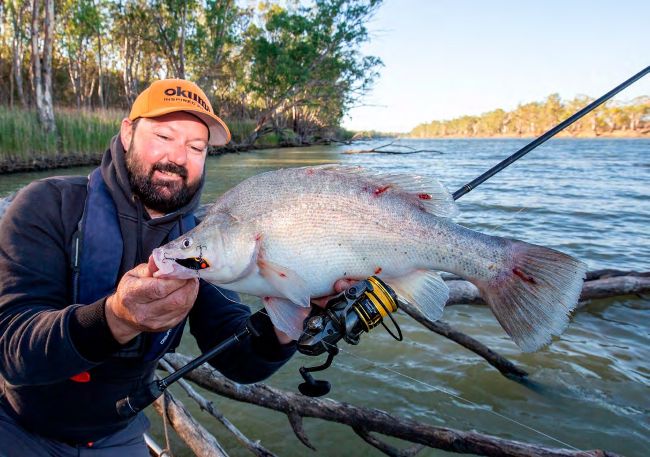
Goldens pull hard at this size